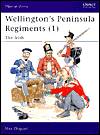Book
Review:
Wellington's Peninsula Regiments:
The Irish
By
Mike Chappell

 It's
hard to believe but some 40 per cent of the British army during
the Revolutionary and Napoleonic Wars are believed to have been
Irishmen.
It's
hard to believe but some 40 per cent of the British army during
the Revolutionary and Napoleonic Wars are believed to have been
Irishmen.
The
hard-fighting soldiers from the Emerald Isle were spread throughout
all arms of Wellington's army but, in Wellington's Peninsula
Regiments: The Irish, Mike Chappell focuses on those with
a official Irish identity.
They
are the 4th (Royal Irish) Dragoon Guards, 18th Hussars, 27th (Enniskillen),
87th (Prince of Wales' Own Irish) and the 88th (Connaught Rangers).
The
five regiments had varying levels of success in the Peninsula
from the 4th's "Bad War" to the fame and renown won
by the Connaught Rangers.
After
an interesting introduction to Anglo-Irish history Chappell looks
at each regiment individually and paints a warts-and-all picture.
For
example the 4th seemed permanently stricken with illness, lost
almost all its horses and - for some three months - seems to have
disappeared from the history books.
The
18th earnt the wrath of Wellington after Vittoria when they helped
pillage King Joseph Bonaparte's treasure wagons and then behaved
badly in the streets of the town. Wellington said: "The 18th
Hussars are a disgrace to the name of soldier."
The
infantry regiments behaved in a better way.
The
27th Enniskillens lost only four men during the terrible 1812
retreat from Burgos while other regiments lost hundreds. Their
battle honours included Peninsula, Badajoz, Salamanca, Vittoria,
Pyrenees, Nivelle, Orthes and Toulouse.
The
87th won the nickname the Faugh-a-Ballaghs (Clear the Way) for
their heroics at Barrosa and also the Eagle Catchers for Sergeant
Patrick Masterton's capture of a French Eagle. Their battle honours
included Peninsula, Talavera, Barrosa, Nivelle, Vittoria, Orthes
and Toulouse.
The
88th had early disciplinary problems that earnt the public hatred
of General Sir Thomas Picton who said they were more footpads
and robbers than Connaught Rangers. It took the regiment some
ferocious fighting throughout the war to win recognition from
Picton who refused to accept that they were arguably the best
single regiment in the British army.
Mike
Chappell has backed up his interesting histories with some first-rate
colour drawings of the Irish regiments in uniform. There are black
and white images of some of the leading characters and incidents
of the Peninsular War, including the capture of the Eagle and
the Jingling Johnny taken by the 88th at Salamanca.
A
terrific read.
-
Richard Moore
8/10